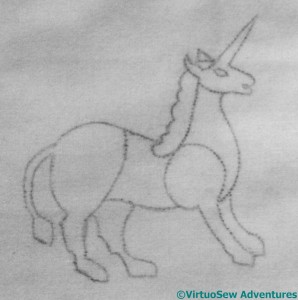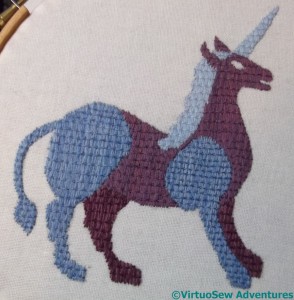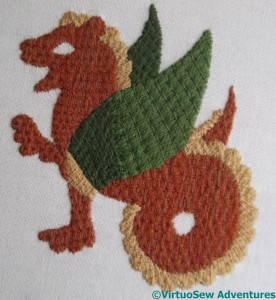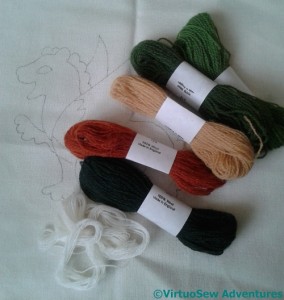Tag: wool
Still More Laid and Couched Work – The Swan
The Swan is a much simplified rendition of a photographed one. I decided in the end to change the lines on the nearer wing, so it more clearly grows from the body of the bird, but one of the great advantages of laid and couched work is that it covers such infelicities of drafting – just so long as you remember to ignore the lines that you had decided to ignore (if you follow me…)!
It still looks a little too naturalistic, but the colours will help (blues and purples, like the Unicorn). I will have to work out suitable embellishments for the wings in due course, as well, and that will also help. As it happens, the layer of laid and couched work gave me quite enough trouble!
I wanted to work the body in the pale blue, to maintain at least some link with the real thing (after all, shadows on white often look blue…).
That made it possible to make sure that I reminded myself to include the forward edge of the nearest wing in with the body.
Then the more distant wing clearly had to be in purples as being more distant and helping to throw the body forward visually. And then I came to a grinding halt – which may explain why you haven’t seen the wretched thing.
I enjoy the technique enormously, but it’s taken me all summer to ignore it and clear my head of colour schemes I hated, come back to it, and try again.
More Laid and Couched work – The Unicorn
I enjoyed working Rusty and Spots in the Opus Anglicanum Stitchalong so much I decided I wanted to do some more laid and couched work.
I rummaged around in my heraldry books and online for medieval unicorns (for a quadruped) and swans (for something winged), and produced something of a synthesis. Some of the medieval unicorns had leopard feet, and one of them had a curly, piggy tail. Mine has vaguely leopardly feet, and a lion’s tail. I’ve sized him so that he fills the same space as did Spots.
It occurred to me that I may want to work medieval creatures in the corners of the Vision of Placidus, when I get that far. I was going to use Rusty, Spots, and their friends, but then I realised that in that context, it would be more appropriate to the story of conversion to use the symbols of the Evangelists – the winged ox, ram, man, and eagle.
So I’m still not sure what I will do with these present creatures when they are done..
Since I am using existing stores here, and I wasn’t sure I would have enough of the colours I used for Rusty and Spots, I moved on to a different colour range – purples and blues. These aren’t the slightly fluffy Appleons wools I used for the other two, but are rather smoother, softer version.
Again, I’m stretching out the colours by threading two colours in the needle for the underlayer. And my goodness, doesn’t it grow quickly!
Spots The Eeyoropard
Under Rusty’s very bright and beady eye, I got started on the companion that Tanya provided for him in the Stitchalong on her blog, Opus Anglicanum.
Which turned out to be a Leopard!
This closeup of his head and neck gives you a chance to see the two different shades used side by side in the underlayer of the laid and couched work.
Once I’d finished the couching – in a modern twist, Tanya suggested working all the couching in a single colour, so that the Dragon and the Leopard will offer two versions of the same stitch – I had a slight false start with the outlining. When I tried the dark chestnut red, I wasn’t entirely happy with it. I’m not sure quite why, but perhaps it simply wasn’t distinctive enough against the orangey-red.
I went back to the dark green I used on Rusty, and used the same creamy yellow for the highlights. I don’t think I put in quite the same highlight twiddles as Tanya put on hers, but I like him just the way he is.
Apparently the Leopard of the medieval bestiary is a gentle creature – in spite of the fearsome claws, and according to Tanya, they all look “terminally grumpy”. I was talking about this with my friend @Matheknitician a week or so back when she accosted me at the MathsJam weekend, saying she was desperate to know what I was going to do with Rusty, and a day later she sent me a message suggesting that we should call Spots an Eeyoropard.
So, ladies and gentlemen, – Spots the Eeyoropard! Please be nice to him – he’s rather shy..
Rusty The Dragon
I did comment that the laid and couched work romps along, and once I got going, it really didn’t take long at all to finish the first layer.
In the interests of being sure of having enough thread to complete the Dragon, I used two shades of rust-coloured wool for his body. The underlayer of surface satin stitch is worked using two strands – making it possible to blend the threads – while the couching stitches are worked using a single strand.
Looking once more at Tanya’s Dragon on the Flickr Group, I realise that I’ve not quite followed her stitching angle in all places. but I’m very happy with how the first layer turned out.
Once the first layer is done, there are details to be added.
And my goodness, what details!
There was a slight false start, because the creamy-white was too light, the wrong texture, and simply looked wrong.
Since the details are worked in split stitch, the necessary unpicking was a severe trial. However, the combination of a pair of tweezers and my brand new embroidery scissors from Ernest Wright and Sons Ltd (bought when I heard of them following a BBC article) made it as easy as it could be (still not very easy, though!).
I finally picked a creamy shade, lighter than pale yellow I used for his crest, but in the same family. It turned out really well, and even his green teeth don’t detract from his charm. He looks a very genial fellow, and I’ve named him Rusty.
Stitch A Long with Opus Anglicanum
Do I really need another project to fit in, I wonder?
Well, yes, I think I do. Over on her blog, Opus Anglicanum, Tanya Bentham is running a medieval stitchalong, and quite simply, when she showed us a picture of the dragon she’d designed for us, I fell head over heels in love. He’s absolutely adorable, and I really didn’t care that I’m running short of time in any one week to do anything at all!
I decided not to buy a kit, since I have more wool thread than I know what to do with (remember my stash-busting canvaswork?), but I did buy some of the wool fabric Tanya suggested, and then rifled through my stash. Most of the wool is Appletons, but the creamy-white for highlights is a remnant of something rather smoother and silkier.
Maybe I’ll make some progress with the stash-busting, after all!
As it happens, I’m trailing slightly behind the stitchalong – and my blog is trailing behind my progress, because I’ve been enjoying stitching too much to stop and write about it.
The “colouring in” element of the design is worked in laid and couched work, which consists of three layers, in modern terms – surface satin stitch, with long couching stitches at right angles, which then in turn are tied down at intervals. Furthermore, it fairly romps along, which makes a lovely change after all that painstaking or nué earlier in the year!
There are several people taking part in the the stitchalong, not all of them bloggers, so Sue set up a Flickr group so that we could encourage one another..
A Hug for A Handbag
Sometimes there is nothing you can do for people but give them a hug; sometimes even that is rendered difficult, or even impossible, by distance. For those occasions, I’ve created a Hug For a Handbag. It’s a small square of snuggly cashmere blanketing, embroidered with the word “Hug” and with a small embroidered motif on the top. I have backed these with another layer of cashmere, to make them even snugglier.
The rose on the Rose Hug is worked in bullion knots, which were not among my favourite stitches, but I’ve warmed to them because the rose seems to have worked so well. The inner knots are shorter, and worked using a single thread, while the outer ones are not only long enough to have involved a great deal of wrangling to get them to settle nicely, but worked using a double thread.
The leaves are worked in nested fly stitches, and the stems in stem stitch (of course!), with tiny thorns of straight stitch alternating with the leaves.
You can tell that I have warmed to bullion knots, because I used them for some of the flowers of the gorse on the Gorse Hug. The buds are French knots, and the thorns and sprigs are worked in fly stitches, using single threads instead of the double thread used for the stems.
This is a wonderful use for some gorgeous woollen threads I bought somewhere in Pembrokeshire ten years or so ago (unlabelled, but they are so soft and lovely I wonder whether they came from Renaissance Dyeing) and some more, bought in Australia, which come from Gumnut Yarns). They have been a sheer delight to use. There’s a lovely misty blue in among them, too, so I am thinking of another design, of Lavender, to make up to have ready next time I need a Hug to send out.
But on the other hand, I rather like stitching a Hug with the recipient in mind. Maybe they’ll feel the hugs I was thinking when they receive the gift.
















